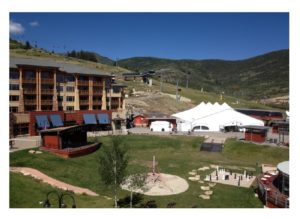By Paul Huppertz,
For the second consecutive year, I attended the Material Handling & Logistics Conference (MHLC) in Park City, UT and for the second year, I heard the message of optimism. With over 400 attendees and almost 100 sponsors, the 2014 MHLC was the largest ever, demonstrating that many companies are investing time and resources to network, learn what others are doing and find solutions to their key supply chain challenges. I spoke with a number of other attendees working on their own major expansion projects and we shared thoughts and experiences on common areas of concern. Common themes are multi-channel and omni-channel fulfillment, larger SKU offerings and integrating systems.
This year’s content was organized in six tracks covering topics such as Leadership, Operations and Innovation. General sessions featured high-quality speakers such as former President George W. Bush, Boxer Sugar Ray Leonard, Blue Angel pilot John Foley and GoogleX Director Mike Cassidy. The entertainment portion was highlighted by Monday night’s Cheap Trick concert.
Along with Jerry Pimental, VP Distribution with Ahold/Stop & Shop, I presented Chapter Two of the Peapod case study. Peapod is the e-Commerce grocery division of Ahold (Stop & Shop, Giant Grocery stores). Chapter One (MHLC 2013) focused on the design of the automated fulfillment center located in Jersey City, NJ and the long list of critical design challenges and how decisions were made regarding use of automated material handling. The Progress Group has worked with Peapod from conceptual design to ongoing ramp up and stabilization efforts of the new facility.
In July, the multi-temperature facility of over 300 thousand square feet began shipping orders. The design includes 5 aisles of Dematic Multishuttles, a goods-to-person “Put Wall,” zone routed conveyor, a high speed shipping sorter and other features. This year we covered the story of the construction phase, MHE installation, system testing, go-live and ramp up. Like most large scale, complex sites, there were things that went smoothly along with some bumps in the implementation path. The important takeaways from this effort include:
• Don’t let upstream schedule delays absorb time needed for testing and training…delays will happen along the way and at some point, all contingency time is exhausted. The natural tendency is to squeeze testing and training. Set hard minimums on the time for these important tasks.
• Set realistic expectations on start-up, stabilization and ramp up of systems and MHE – there are a lot of moving parts…take stock of the “new” things that have to be fully checked out and ready for production before go-live:
− WMS, Controls software and integration (how many modules and interfaces?),
− MHE components (mechanical adjustment, burn in, controls logic),
− Management and supervisory team training,
− Staff training (how many functions, how many people, what early turnover is likely?),
− Maintenance staff training (is there specialized equipment to support, parts inventory?),
− Inventory control systems and processes,
− Problem resolution tools, activity reporting and exception reporting.
• If at all possible, separate the initial launch of WMS, controls software and MHE…any way to reduce the amount of “new” things to start will reduce risk during testing and go-live. WMS is frequently the source of delays and heartburn, take it off the facility launch critical path if you can.
• Get inventory right from day one…shortcuts in receiving, or poorly trained staff will only make life harder once operations commence. Take the time to do it right.
• Have a plan in place for transition from designers and implementers to operators – Design tweaks, system mods and process changes are all part of the startup experience. Be clear on who has primary responsibility for determining what changes will be made and when that responsibility shifts.

It was a pleasure to attend the MHLC again; it’s a quality event, was not overly dominated by sponsors, and the attendee size allowed great interaction. I definitely recommend it to anyone looking at a big project or just for professional growth. As a bonus, you won’t find many (maybe not any) supply chain conferences in a more picturesque setting.


